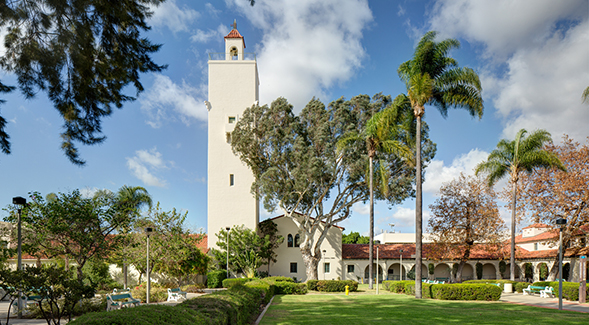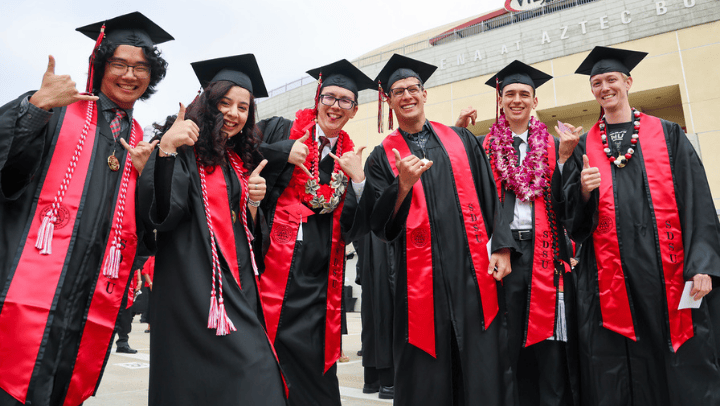SDSU Named One of the Nation's Most Environmentally Responsible Campuses
A cascade of sustainability initiatives, LEED certifications and academic offerings contribute to The Princeton Reviews recognition in its 2022 Guide to Green Colleges.

San Diego State University has once again been recognized for its commitment to sustainability by The Princeton Review.
The annual “Guide to Green Colleges,” released on Oct. 26, recognizes institutions that are making exceptional commitments to sustainability and making environmentally responsible decisions on campus.
“As a university, we are proud to be recognized yet again for being a dedicated leader in sustainability,” said SDSU President Adela de la Torre. “Sustainability continues to be an aspect of the university’s identity and our strategic plan, as our campus community understands the importance of being environmentally responsible and the impact we are having on the future of our community and land.”
Of the 835 campuses considered this year, The Princeton Review chose 420 colleges based on 25 data points, including academic offerings, campus policies, initiatives, activities and the career preparation offered to students who are interested in green jobs.
The Princeton Review’s continued recognition of SDSU’s sustainability efforts aligns with the university’s strategic plan priority to build an environmentally sustainable future for the campus community and protect the legacy of the Kumeyaay land upon which the university resides.
SDSU continues to prioritize environmental sustainability in its academic offerings and initiatives on campus, including a major and minor in sustainability and numerous other academic programs that focus on sustainability.
The university also remains focused on prioritizing sustainability in building construction on campus. SDSU has 14 buildings with Leadership Energy and Environmental Design (LEED) certification, including a LEED Double Platinum certification for the Conrad Prebys Aztec Student Union, with completion nearing on Aztec Recreation Center addition and renovation, also projected to achieve Double Platinum. SDSU is the only campus in the California State University system with two LEED Double Platinum buildings. Residential buildings with LEED certification include SDSU’s newest residential community, Huaxyacac, along with South Campus Plaza North, South Campus Plaza South, Tenochca, Tula and Zura.
Other buildings that have achieved LEED certifications in recent years are the Mission Bay Aquatic Center, the Children’s Center, Storm and Nasatir Halls, the Aztec Recreation Center, Aztec Aquaplex and Viejas Arena.
Through the strategic plan, and related to alternative transportation, SDSU has launched a pilot shuttle service between SDSU and SDSU Imperial Valley to improve the connection between the two campuses while eliminating individual commutes by faculty, staff, and students. In addition, SDSU has established the new Office of Energy & Sustainability and is in the search process for the inaugural director of the office.
“With the new Office of Energy & Sustainability, SDSU will work to elevate the priority and focus of our efforts around areas such as energy conservation measures, greenhouse gas reduction, and sustainable policy and practices for the institution,” said Eric Hansen, SDSU associate vice president of Business Operations.
The final phase of the strategic planning effort is to update SDSU’s Climate Action Plan this year with additional actions, which will allow for more aggressive timelines, and which will leverage and include both SDSU Imperial Valley and SDSU Mission Valley.
Looking forward, construction on the new Aztec Stadium at SDSU Mission Valley continues with sustainability as a top priority,which is being designed to be LEED Gold certified . Nearly 90% of the old San Diego Stadium is being recycled or reused in the construction of SDSU Mission Valley.
With San Diego and SDSU’s sustainability efforts in mind, SDSU Mission Valley aims to both harness the power of the environment and protect it. At full buildout across the SDSU Mission Valley site, more than 400,000 square feet of available roof space will incorporate solar panels, and each non-stadium building will be designed to achieve or exceed LEED Silver certification. The site is also designed with more than 80 acres of total park and open space, four miles of hike and bike trails, and nearly 70 varieties of California and San Diego native plants, trees, shrubs and grass will be planted.
More information on SDSU’s environmental and academic efforts and achievements can be found on The Princeton Review’s profile of the campus.



